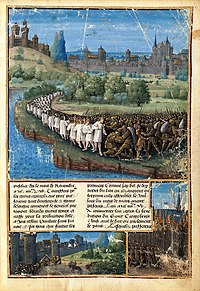
Back حملة الفقراء الصليبية Arabic الحمله الصليبيه الشعبيه ARZ Cruzada de Pedro l'Ermitañu AST Народен кръстоносен поход Bulgarian জনগণের ক্রুসেড Bengali/Bangla Seljački krstaški rat BS Croada Popular Catalan Lidová křížová výprava Czech Volkskreuzzug German Σταυροφορία του λαού Greek
| People's Crusade | |||||||
|---|---|---|---|---|---|---|---|
| Part of the First Crusade | |||||||
 The defeat of the People's Crusade Illustration by Jean Colombe (from Passages d'outremer) | |||||||
| |||||||
| Belligerents | |||||||
| West European Catholics | Sultanate of Rum | ||||||
| Commanders and leaders | |||||||
| Kilij Arslan[3] | |||||||
| Strength | |||||||
|
20,000 crusaders[4] (initially 40,000)[5] | Small Army | ||||||
| Casualties and losses | |||||||
| Extremely high; near-complete destruction[6] | Relatively low | ||||||
The People's Crusade was the beginning phase of the First Crusade whose objective was to retake the Holy Land, and Jerusalem in particular, from Islamic rule. In 1095, after the head of the Roman Catholic Church Pope Urban II started to urge faithful Christians to undertake an armed pilgrimage to Jerusalem, the People's Crusade was conducted for roughly six months from April to October 1096. It is also known as the Peasants' Crusade, Paupers' Crusade or the Popular Crusade as it was executed by a mainly untrained peasant army prior to the main church-organized crusade. It was led primarily by Peter the Hermit with forces of Walter Sans Avoir. The peasant army of this crusade was destroyed by the forces of the Seljuk Turks under Kilij Arslan at the Battle of Civetot in northwestern Anatolia.
The People's Crusade was the first, largest, and best documented of the popular crusades. The start of the more official and fully church-backed crusade, called the "Princes' Crusade", occurred a few months later and was better organized, better armed, and better funded; it was also successful.
- ^ John France, Victory in the East: A Military History of the First Crusade, (Cambridge University Press, 1997), pg. 159
- ^ Paul L. Williams, The Complete Idiot's Guide to the Crusades, p. 48
- ^ Tom Campbell, Rights: A Critical Introduction, p. 71
- ^ J. Norwich, Byzantium: The Decline and Fall, 35
- ^ J. Norwich, Byzantium: The Decline and Fall, 33
- ^ Jim Bradbury, The Routledge Companion to Medieval Warfare, p. 186